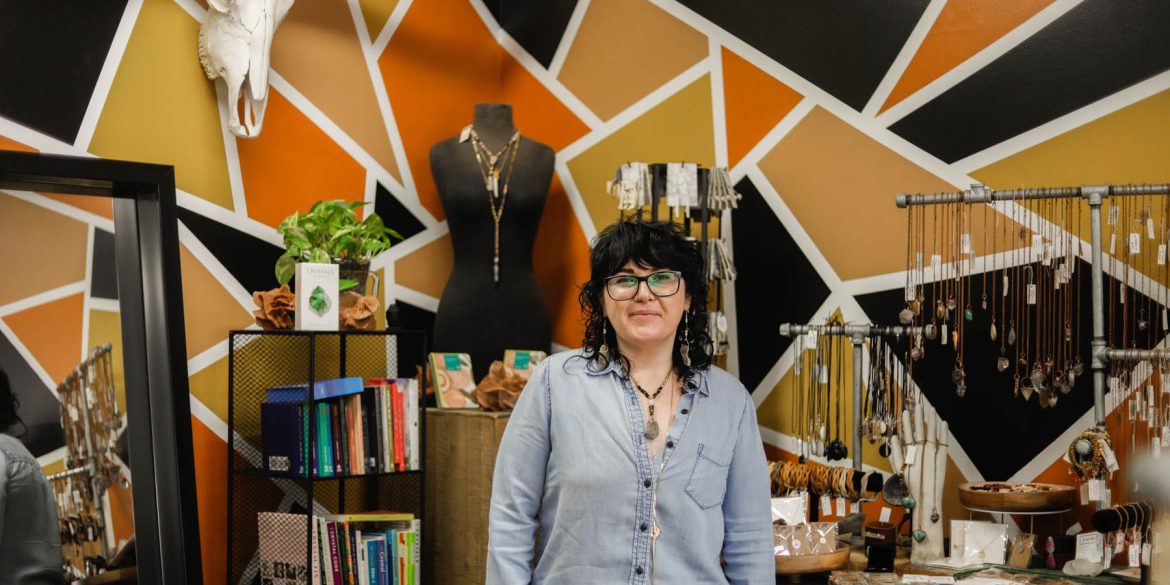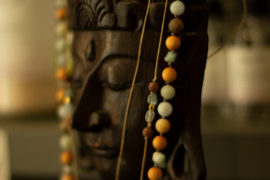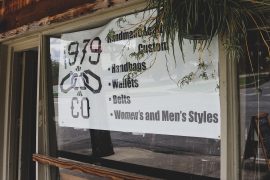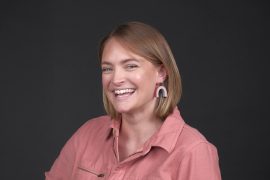Almost a decade ago, Brittany Spencer founded The Local Radish. Originally centralized around making and selling canned foods and body butters, Spencer eventually returned to her roots in jewelry making, a passion she has maintained since high school. She made it a priority to carry over the importance of natural elements from The Local Radish’s original products into her new direction, namely in the form of crystals. After years of festivals and conventions, she finally purchased a physical location for her business. Spencer worked tirelessly, with the help of her family, to make the space her own and a perfect representation of her brand. Besides her storefront, Spencer’s work can also be explored on her website, Instagram and Facebook.

What do you make/sell?
I make all the copper jewelry that you see. I make all that jewelry. We also make a bunch of the incense that we carry. What we don’t make we source from other makers locally and abroad.
How long have you been doing this?
Nine and a half years.
What retail locations can people find your product? Is it just the storefront or do you still do festivals?
I haven’t done any festivals recently. However, I plan to once I get everything in order with the store. I do have other retail locations such as Salvage Sisters in Franklin, Indiana. I also have it in Stomping Ground which is close to downtown. It’s a newer store; it’s by the new Amelia’s that just opened up. We also have products at French Pharmacie Flea and Broader Bowl. Lastly, my jewelry is also in a store called Society in Valparaiso, Indiana.
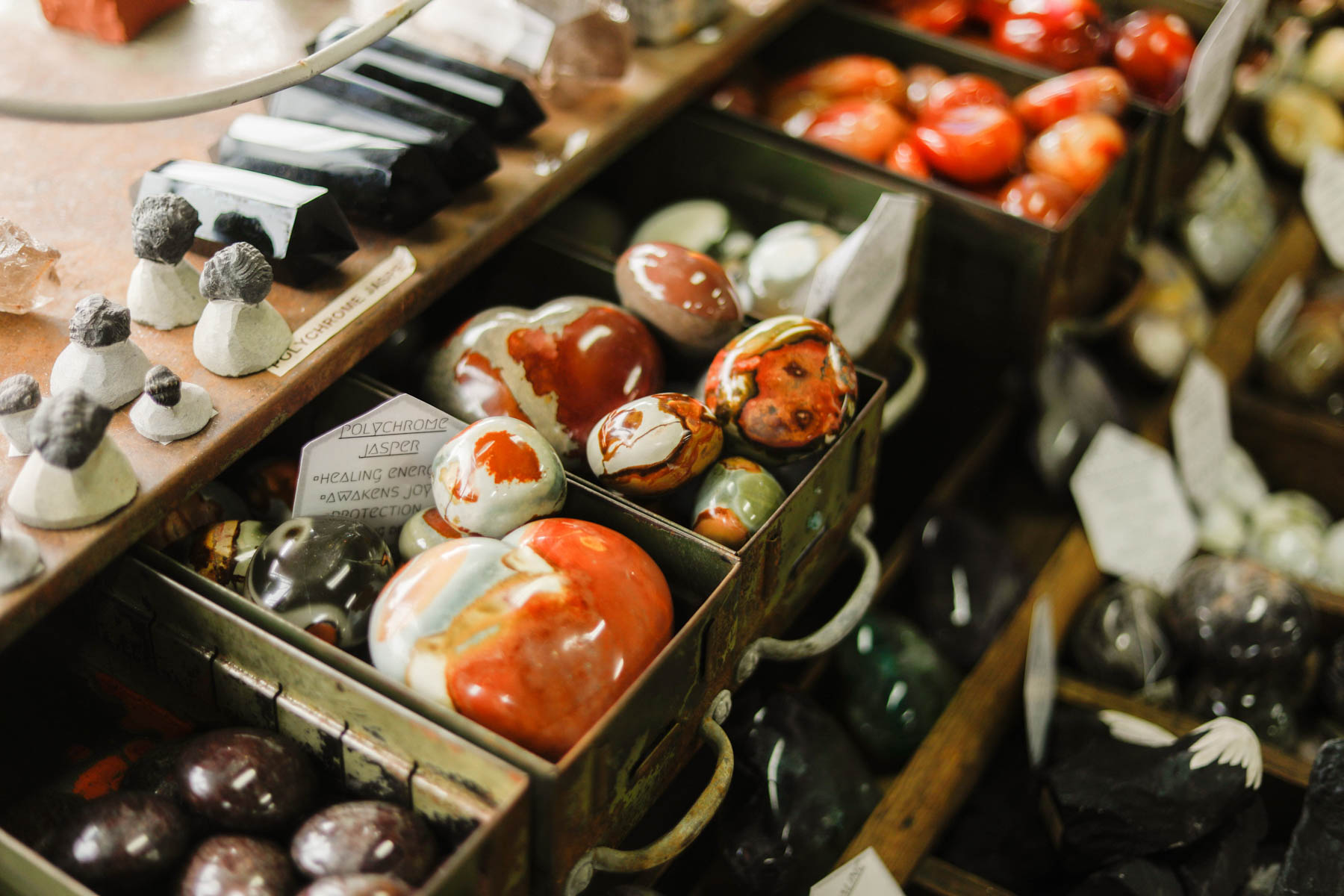

What piqued your initial interest in designing your products?
I have been making jewelry since I was in high school and was pregnant with my daughter. When The Local Radish started, I was canning foods and making body butters. But, my heart was making jewelry. I just love that. I incorporated all of the natural aspects that we were already using into jewelry making. In fact, some of the jewelry that I make is made from plants. I’m an avid gardener, so a lot of the herbs that I carry I actually grow myself. I love the natural aspects of crystals. We used to travel when I was little to go get crystals, so it’s just second nature by now.
What principles do you use when designing?
I will not create anything if I’m feeling awful. If I’m really upset, I don’t want to put the energy that I’m feeling into my joy. If I’m going through a really, really hard time, I will set my work down and come back to it later. I do this because I feel like what we’re creating, we put our energies into.
Who and/or what influences your design style?
Nature. I have always been one to go foraging. Even when I was little, we went mushroom hunting. I found all of the things that other people were like, “Why does that interest you?” I just love nature. I love dried flowers. Crystals just went right along with that.

How would you describe your design, aesthetics and values?
I would say that I have a very natural, warm-tone aesthetic. I lived in Florence, Arizona for quite some time. I feel like that is part of my design. When it comes to values it’s a huge, important part of the Local Radish that the values of the artists that we carry align with our own. We are very LGBTQ friendly here. It’s very important to us that the makers that we purchase from are also investing into a change in our society. We only purchase from people like-minded in that way.
What comes first for you, the design materials or the design concept?
The design concept comes first. Then I go and find the materials. After that I don’t force myself to make it right then and there. Sometimes I know my plan right away, but sometimes it might take a few weeks to come up with everything for the design.
Could you describe the process of creating a piece from conception to finish?
First I have to find the crystal, then I have to prep the crystal. I make something called an “O-Ring” and adhere it to the crystal. It takes about a week from start to finish to make the jewelry that I make. I have to seal the crystal, so that the solution that it goes into doesn’t affect the actual crystal itself in regards to the density and all that. Once I’ve done that, I have to paint the crystal with a copper paint that’s conductive, which I do about three times.Then I actually put the crystal itself into what’s called a rectifying machine with a copper sulfate solution. Then, I let the copper grow. I don’t know if when you were little your parents ever had anything encased in copper. They used to encase baby shoes, or something like that. It’s essentially like that, except we’re using natural elements instead of materials like shoes.
What is the creative process, in terms of the material selection and labor process?
I can create about twelve pieces at a time. Then, those twelve pieces take a week from start to finish to make. After the piece has been finished in the solution, I then sand, polish and patina the actual piece.
What is your favorite tool and why?
A pair of pliers that I have, I don’t know why. If I don’t have those pliers, it’s a bad day. The way that they feel in your hands, you get partial to that; and those pliers are some that I started out with. They almost make me feel more comfortable as I’m using them.

Describe a piece you’ve created that you’re most proud of, and what was special about it.
It’s actually still here. I kind of hide it sometimes because I love it so much. It’s a marigold inside. Marigolds are flowers that are half in-half out when it comes to spirituality. They’re ones that the Hispanic culture uses for the Day of the Dead. This marigold was from my garden. I grew the actual flower, and then I created jewelry with it.
Describe the commissioning process; what are the best and worst aspects of doing commissions?
When something breaks is the worst. I am working with very unpredictable substances and chemicals. They can be a challenge. Some of them are hazardous material, and there have been times that stones have broken. For that reason, I don’t usually take on personal pieces anymore. Not that it happens often, but the anxiety of that happening is just a little too much for me. Usually I will create custom pieces of stones that I carry. I don’t usually do commissions with people’s pieces because there is a risk of it breaking. If that’s your grandmother’s piece that you’ve had for 20 years, I don’t want to be responsible for something like that breaking. However, I always recommend that they get it set into sterling silver. Then I recommend them to one of my other artists that I carry here.
What advice would you give aspiring designers like yourself?
Don’t give up. A lot of times you have to root for yourself. Those times at home, when you’re staying up till three, four in the morning creating and you’re just like, “I just want to sleep.” Or when you go to a show and it wasn’t the most successful and you get really down, just keep going. You’re literally just building your brand, and there’s going to be the ebb and the flow to where some moments are going to be really high and others are going to be low. Prepare for that. I feel like what we have here is because I didn’t give up and I just kept going, even in the hardest moments. Especially through the pandemic, it was extremely hard. We had paid out a lot of money for festivals that we didn’t get reimbursed for. That’s thousands of dollars lost. This was a huge risk to have a second mortgage for this storefront, but it’s been a blessing overall.
What is one thing that the creative/design community can do in Indianapolis to help grow an audience for custom or handcrafted work?
I think to just purchase more, and make it more accessible when it comes to physical storefronts. Before we got this actual location, I toured all over Indianapolis and surrounding communities looking for spaces to rent. Unfortunately, in some areas, they make it almost impossible to be able to afford rent. Understanding that and giving small businesses and artists a chance and a check is crucial. I’m on the Chamber here in Beech Grove trying to help change the mindset around things like asking artists, “Hey, will you paint these murals and you’ll get good exposure?” That’s their time, so let’s pay them. Exposure alone doesn’t pay bills.
What’s your dream commission or client?
Honestly, I really focus on wanting people to feel comfortable here. When people walk in the door I want them to feel at home. I don’t really have a specific clientele that I’m gearing towards. It’s just so that all people feel love here and all religions feel welcome. It doesn’t matter what type of person you are or any of that. I want people to feel welcome and at home.

What makes your work different from anyone else’s?
I feel like everybody has their own vibe. That really comes through at each location/store that you go to. This space really incorporates who I am, especially in terms of the tones and the natural aspects of this store. I feel like the earthiness of it all really encompasses me.
What’s your most rewarding memory in your business?
It’s kind of small to some, but it’s big to me. How my husband and my kids helped me create this space. We would stay here till three, four in the morning painting. My daughter actually was seven when we did all this. She’s almost nine now. She helped me paint the gold leaf on the triangle on the wall. I dreamed about this store when I was 13 years old. I was in a life coaching class, and some of the things that we talked about I actually feel like I manifested, you know? Having family support from my kids and my husband has been the best for me.
Is there any maker you’d recommend to be highlighted in this series?
It’s hard to pick just one! But some include: Broad Street Jewelry, Into The Pines Jewelry, Urban Utopia, Canned Good Soap, Sea Witch Botanicals, and Status Glow. Broad Street Jewelry is a vintage stone jewelry shop based out of Chicago, and Into The Pines Jewelry is another great jewelry brand that we carry. Urban Utopia is a soap shop run by Indy locals. It’s handmade from all organic ingredients and contains essential oils. Even the wrappers of the soaps are cool; they’re made from organic banana leaves, so they’re completely tree-free. Canned Good Soap is another great soap company. It is female-founded, and based out of Indy as well. They use all-natural ingredients and use recycled aluminum cans to hold their products. Sea Witch Botanicals is also female-owned, as well as eco-friendly, vegan, sustainable, ethically sourced, and all completely handmade. Lastly, Status Glow is a small-batch candle maker based out of Chicago.

